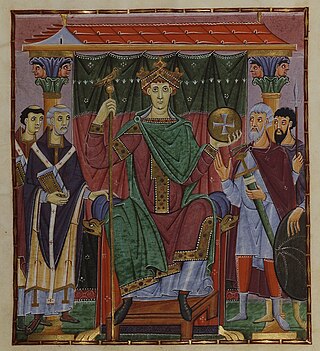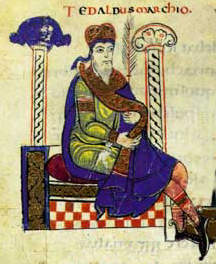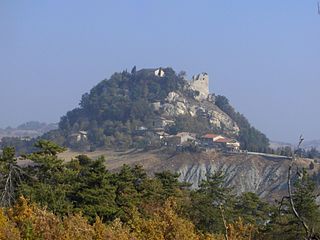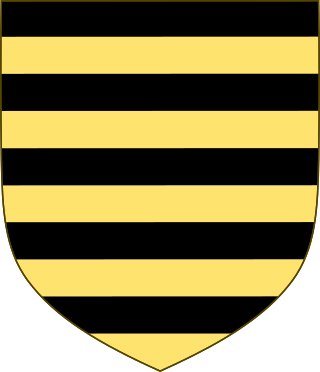
Matilda of Tuscany, also referred to as la Gran Contessa, was a member of the House of Canossa in the second half of the eleventh century. Matilda was one of the most important governing figures of the Italian Middle Ages. She reigned in a period of constant battles, political intrigues and Roman Catholic excommunications, and was able to demonstrate an innate and skilled strategic leadership capacity in both military and diplomatic matters.

Otto III was Holy Roman Emperor from 996 until his death in 1002. A member of the Ottonian dynasty, Otto III was the only son of the Emperor Otto II and his wife Theophanu.

Year 951 (CMLI) was a common year starting on Wednesday of the Julian calendar.

Berengar II was the King of Italy from 950 until his deposition in 961. He was a scion of the Anscarid and Unruoching dynasties, and was named after his maternal grandfather, Berengar I. He succeeded his father as Margrave of Ivrea around 923, and after 940 led the aristocratic opposition to kings Hugh and Lothair II. In 950 he succeeded the latter and had his son, Adalbert crowned as his co-ruler. In 952 he recognised the suzerainty of Otto I of Germany, but he later joined a revolt against him. In 960 he invaded the Papal States, and the next year his kingdom was conquered by Otto. Berengar remained at large until his surrender in 964. He died imprisoned in Germany two years later.

Boniface III, son of Tedald of Canossa and the father of Matilda of Tuscany, was the most powerful north Italian prince of his age. By inheritance he was count of Brescia, Canossa, Ferrara, Florence, Lucca, Mantua, Modena, Pisa, Pistoia, Parma, Reggio, and Verona from 1007 and, by appointment, margrave of Tuscany from 1027 until his assassination in 1052.

Adalbert was the king of Italy from 950 until 961, ruling jointly with his father, Berengar II. After their deposition, Adalbert continued to claim the Italian kingdom until his defeat in battle by the forces of Otto I in 965. Since he was the second Adalbert in his family, the Anscarids, he is sometimes numbered Adalbert II. His name is occasionally, especially in older works, shortened to Albert.

Tedald, of the House of Canossa, was the count of Brescia from 980, Modena, Ferrara, and Reggio from 981, and Mantua from 1006. He used the title of margrave because of his vast comital holdings and their frontier nature. His family's seat was Canossa and he was the son of Adalbert Azzo of Canossa who had supported Otto I against Berengar of Ivrea and Adalbert of Ivrea. His rise was largely due to his loyalty to the Ottonian Dynasty.

The Anscarids or the House of Ivrea were a medieval dynasty of Burgundian and Frankish origin which rose to prominence in Northern Italy in the tenth century, even briefly holding the Italian throne. The main branch ruled the County of Burgundy from the eleventh to fourteenth centuries and it was one of their members who first declared himself a count palatine. The cadet Castilian branch of Ivrea ruled the Kingdom of Galicia from 1111 and the Kingdoms of Castile and León from 1126 until 1369. The Spanish House of Trastámara, which ruled in Castile, Aragon, Naples, and Navarre at various points between the late 14th and early 16th centuries, was an illegitimate cadet branch of that family.

Canossa is a comune and castle town in the Province of Reggio Emilia, Emilia-Romagna, northern Italy. It is where Holy Roman Emperor Henry IV did penance in 1077 and stood three days bare-headed in the snow to reverse his excommunication by Pope Gregory VII. The Walk to Canossa is sometimes used as a symbol of the changing relationship between the medieval Church and State.
Ulric Manfred II or Manfred Ulric was the count of Turin and marquis of Susa in the early 11th century. He was the last male margrave from the Arduinid dynasty. Ulric Manfred's daughter, Adelaide, inherited the majority of his property. Through marriage to Adelaide, Otto of Savoy, a younger son of Count Humbert I of Savoy became margrave of Turin. Their descendants would later comprise the House of Savoy who ruled Sardinia and Italy.

Adelaide of Turin was the countess of part of the March of Ivrea and the marchioness of Turin in Northwestern Italy from 1034 to her death. She was the last of the Arduinici. She is sometimes compared to her second cousin and close contemporary, Matilda of Tuscany.

The House of Canossa was an Italian noble family from Lucca holding the castle of Canossa, from the early tenth to the early twelfth century.

Adalbert II of Ballenstedt, an early member of the House of Ascania, was Graf (count) in Saxony and Vogt of Nienburg Abbey.

The Castle of Canossa is a castle in Canossa, province of Reggio Emilia, northern Italy, especially known for being the location of the Road to Canossa, the meeting of Emperor Henry IV and Pope Gregory VII during the Investiture Controversy (1077).
The Arduinici were a noble Frankish family that immigrated to Italy in the early tenth century, possibly from Neustria. They were descended from and take their name after one Arduin (Hardouin).

Otto I, traditionally known as Otto the Great, or Otto of Saxony, was East Frankish king from 936 and Holy Roman Emperor from 962 until his death in 973. He was the eldest son of Henry the Fowler and Matilda of Ringelheim.
Sigifred of Lucca was a Lombard nobleman and the progenitor of the House of Canossa.
The counts of Chiny were part of the nobility of Lotharingia that ruled from the 9th to the 14th century in what is now part of Belgium.
The County of Piacenza was a county of the Frankish kingdom of Italy. Its centre was the ancient and walled city of Piacenza at the confluence of the Trebbia and the Po, just downriver from the royal capital of Pavia. Much of the county was dominated by the Apennine Mountains. It roughly corresponds to the modern province of Piacenza.
Gerberga, Otto-William's mother, was, by her successive marriages, queen of Italy, margravine of Ivrea (965–970), and duchess of Burgundy (971/5–986/91).














